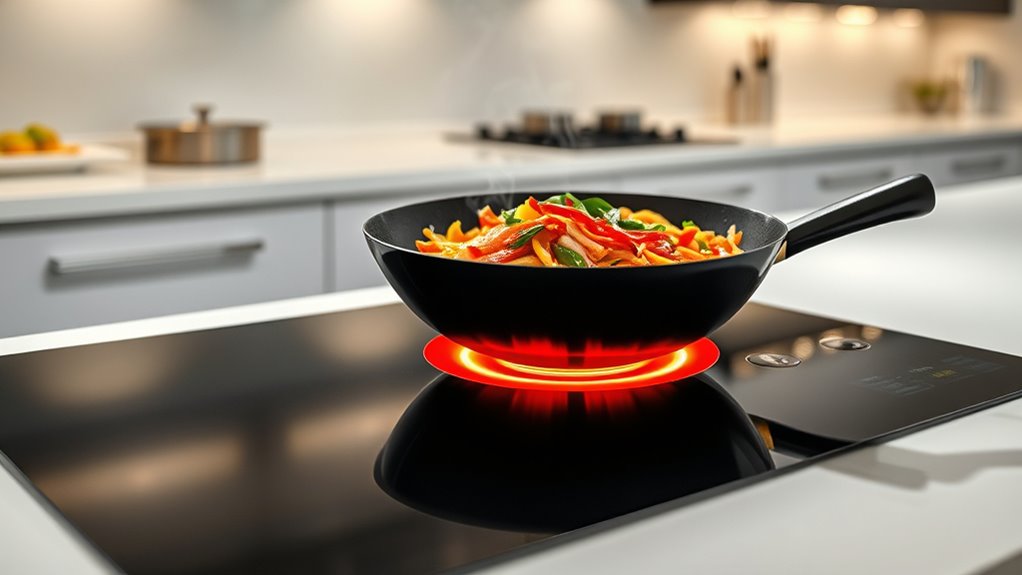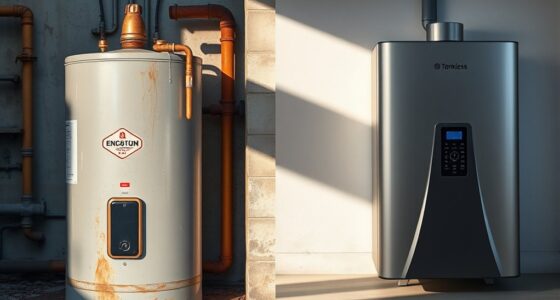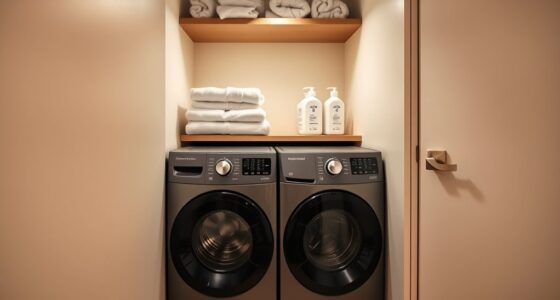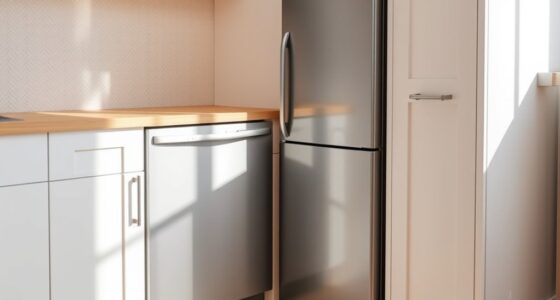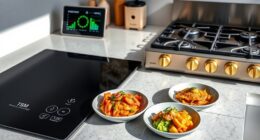Induction wok hobs boost your Asian cooking with faster heat-up times and precise temperature control, making stir-fries and searing more efficient. They use about 85-90% of energy, reducing waste and lowering your utility bills. Using ferromagnetic cookware ensures peak performance, and matching pan size helps maximize efficiency. These features create a more eco-friendly cooking experience without sacrificing authenticity. If you want to know how to get the most out of induction wok hobs, keep exploring.
Key Takeaways
- Induction wok hobs heat quickly and precisely, reducing cooking time and energy consumption during Asian stir-fry dishes.
- High efficiency (~85-90%) minimizes heat loss, making energy use more sustainable compared to traditional gas stoves.
- Compatible ferromagnetic woks ensure optimal heat transfer, maximizing energy performance in high-temperature Asian cooking techniques.
- Proper cookware matching (size and material) enhances energy transfer, reducing wasted energy and improving cooking efficiency.
- Rapid heat-up and precise temperature control support authentic Asian cooking methods while conserving energy.
How Induction Wok Hobs Enhance Cooking Speed and Efficiency
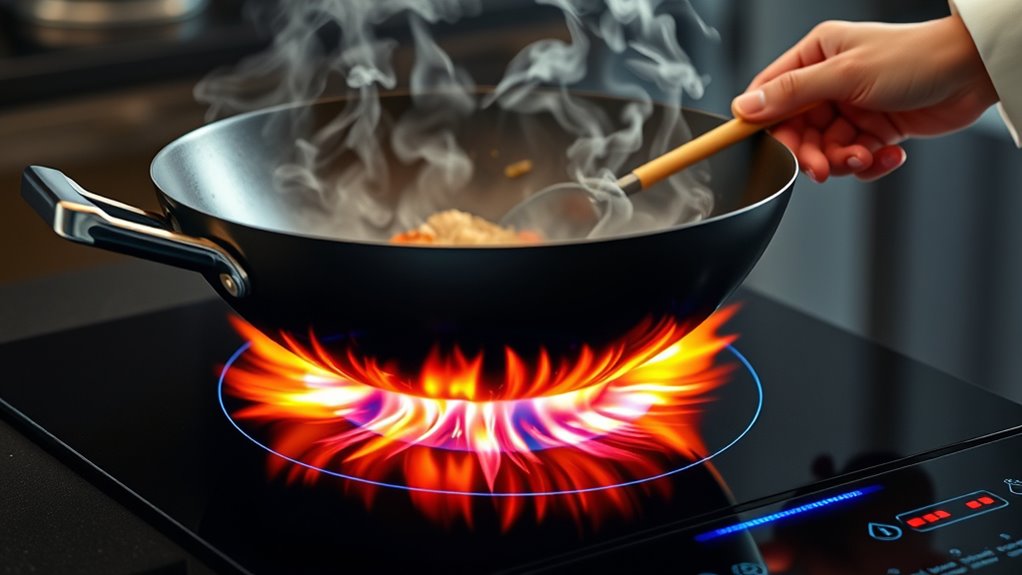
Induction wok hobs substantially boost cooking speed and efficiency by delivering rapid, precise heat. You’ll notice water boils 40% faster—around 3 minutes 12 seconds for 5 liters—thanks to direct electromagnetic energy that heats the pan instantly. Unlike gas or electric coils, induction offers quick heat-up times and maintains consistently high efficiency (~76%), even with smaller pans. High power output (3.5 to 5 kW) enables fast searing and high-temperature stir-frying, while quick on/off responsiveness lets you adjust heat instantly. Precise temperature control within ±1°C ensures your dishes cook exactly as needed, avoiding over- or under-heating. Automated features and digital controls streamline your workflow, reducing wait times. Additionally, the high efficiency of induction technology minimizes energy loss, making it an environmentally friendly choice. Overall, induction hobs markedly accelerate cooking processes and improve productivity in busy Asian kitchens.
Energy Savings and Environmental Benefits in Asian Cuisine
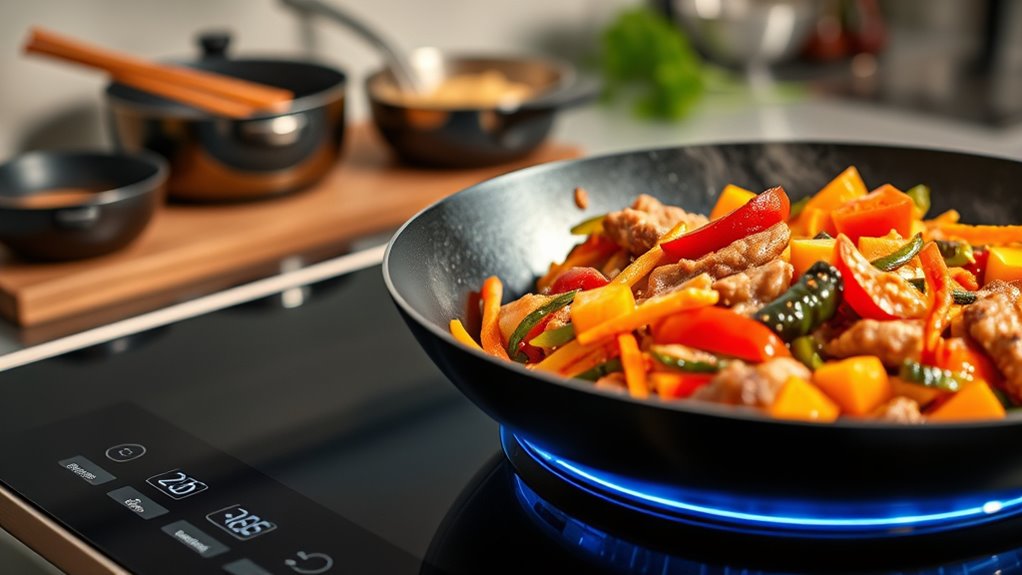
Using induction wok hobs can markedly boost energy efficiency compared to traditional cooking methods, leading to both cost savings and environmental benefits. These hobs achieve about 85-90% efficiency, far surpassing gas stoves at 31-50%, with minimal heat loss—only about 10-15%. This high efficiency means you use less energy per cooking task, which cuts household energy bills and reduces carbon emissions from electricity generation. In Asian cuisine, rapid heating and stir-frying become more sustainable, with energy use dropping up to 45% and annual savings around 57 kWh per household. Additionally, induction cooking lowers indoor air pollution by eliminating combustion fumes and minimizes excess heat release, supporting a healthier environment and reducing cooling demands in hot climates. Incorporating advanced heat transfer technology can further enhance cooking efficiency and safety.
Compatibility With Traditional Wok Cooking Techniques
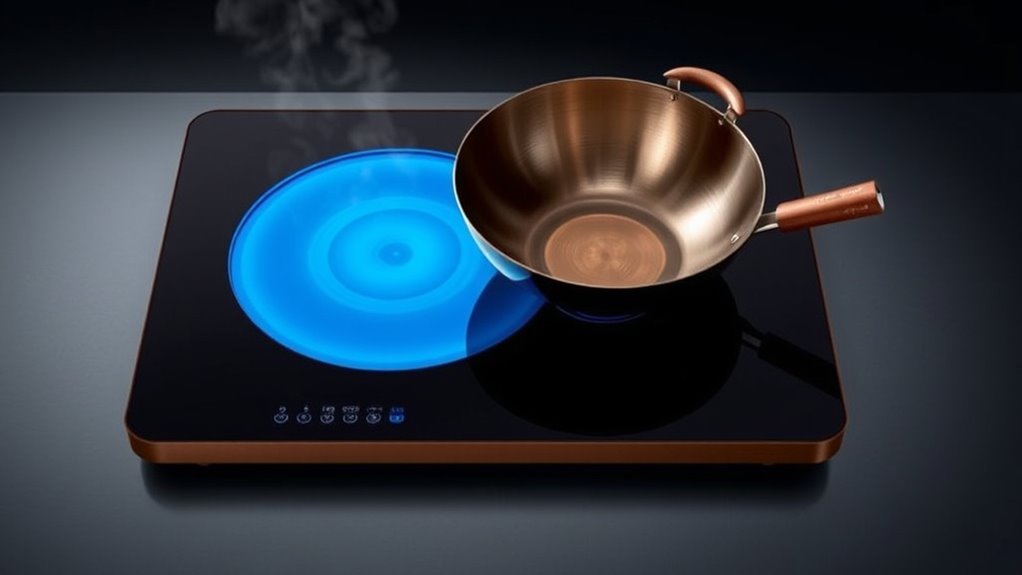
While traditional wok cooking techniques are deeply rooted in high heat and dynamic motion, adapting them for induction hobs requires some adjustments. To make the most of induction, you need to understand material compatibility and shape limitations. Here are four key points:
- Use ferromagnetic woks, like carbon steel or cast iron, for effective heating. Most woks are not made from ferromagnetic materials needed for induction heating (e.g., stainless steel, carbon steel, cast iron).
- Flat-bottomed designs ensure better contact and heat transfer, unlike traditional round-bottom woks. This is especially important because the flat surface promotes efficient energy transfer, which is a key aspect of induction cooking and its performance.]
- Season your wok properly to build a non-stick surface and withstand high heat.
- Employ accessories like wok rings or induction disks to stabilize round-bottom woks, though this may reduce efficiency.
Adjustments are necessary, but with the right tools and techniques, you can still achieve authentic stir-frying and searing.
Cost Implications and Market Adoption of Induction Wok Hobs

The market for induction wok hobs is experiencing rapid growth, driven by increasing consumer demand for energy-efficient and modern cooking solutions. The global tabletop induction wok market was valued at USD 450 million in 2024 and is projected to nearly double to USD 850 million by 2033, with a CAGR of 7.5%. Overall induction hob sales are expected to reach USD 48.7 million by 2033, growing at 9.5% annually. Although induction woks have higher upfront costs due to advanced technology, their efficiency and lower maintenance expenses make them attractive. Urban consumers value safety, speed, and ease of cleaning, boosting adoption. Incentives for energy-efficient appliances and growing interest in Asian cuisine further accelerate market penetration, especially in regions prioritizing eco-friendly, space-saving cooking appliances. The cost implications of these advanced appliances are balanced by their long-term savings and efficiency benefits, contributing to increasing market adoption.
Tips for Maximizing Energy Performance With Induction Woks
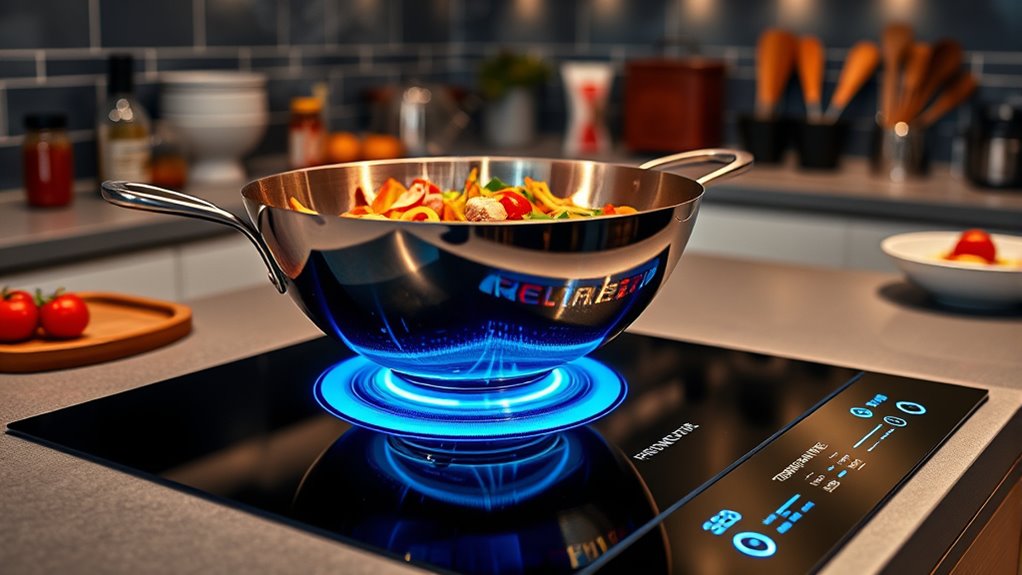
Maximizing energy performance with induction woks starts with selecting the right cookware. Make sure your pan has a magnetic base, like cast iron or stainless steel, to guarantee compatibility. Use cookware that matches the size of the induction zone to optimize energy transfer. Here are four tips to boost efficiency:
- Choose the right material – opt for pans with high heat conductivity for quicker cooking.
- Test with a magnet – confirm that your cookware is induction-compatible.
- Match pan size to the burner – smaller or larger pans waste energy if mismatched.
- Control heat precisely – use the rapid temperature adjustments to avoid overheating and save energy.
These steps help harness induction’s efficiency, reducing waste and improving cooking speed.
Frequently Asked Questions
Can Induction Wok Hobs Be Used With Non-Ferrous Cookware?
You might wonder if induction wok hobs work with non-ferrous cookware. Typically, they don’t unless the cookware has a magnetic layer, like a magnetic base added to aluminum or copper pans. Non-ferrous materials like glass, pure aluminum, or ceramic won’t work unless specially adapted. To verify compatibility, check if your cookware is ferromagnetic or has a magnetic base. If not, it won’t heat properly on an induction wok hob.
How Do Temperature Controls Differ Between Induction and Traditional Woks?
Imagine turning a dial and instantly feeling the heat surge or subside beneath your wok, the flames flickering with your touch. That’s how induction controls differ from traditional woks—they respond immediately to your adjustments, providing precise, consistent heat. Traditional woks, on the other hand, require manual, often lagging tweaks, with heat gradually rising or falling. Induction offers sharp, responsive control, while traditional methods rely on more gradual, manual regulation.
Are Induction Woks Suitable for High-Heat Stir-Frying?
You’re wondering if induction woks work well for high-heat stir-frying. They’re actually quite suitable because they generate rapid, precise heat up to around 425°F, essential for searing and quick cooking. The focused heat minimizes energy waste and keeps the wok hot enough for traditional stir-frying. However, keep in mind that flat-bottom models may limit tossing techniques, so you might need to adjust your cooking style slightly.
What Maintenance Is Required for Induction Wok Hobs?
You’ve got to stay on top of maintenance to keep your induction wok hob running smoothly. Wipe spills immediately to prevent residue buildup, and use soft cloths and gentle cleaners to avoid scratches. Regularly check for any signs of wear or damage, and schedule professional servicing annually if possible. Think of it as giving your appliance a health check, so it continues to perform like a champ and lasts longer.
Do Induction Woks Affect the Flavor of Asian Dishes?
You might wonder if induction woks change the flavor of Asian dishes. They actually help preserve and enhance flavors because of rapid, even heating that locks in taste and nutrients. Precise temperature control prevents overcooking delicate ingredients, maintaining authentic flavors. Plus, the even heat distribution avoids hotspots, ensuring consistent taste. Overall, induction woks support better flavor retention, making your dishes more vibrant and authentic without compromising traditional taste.
Conclusion
Switching to induction wok hobs can transform your Asian cooking experience. Imagine preparing a stir-fry in half the time, just like a professional chef, while saving energy and reducing environmental impact. For example, a restaurant owner switched to induction woks, cutting their energy bills by 30% and improving cooking efficiency. Embrace this modern technology to enjoy faster, greener, and more precise cooking—making your culinary creations even more enjoyable.
I’m Theodore, and I love tiny houses. In fact, I’m the author of Tiny House 43, a book about tiny houses that are also tree houses. I think they’re magical places where imaginations can run wild and adventures are just waiting to happen.
While tree houses are often associated with childhood, they can be the perfect adult retreat. They offer a cozy space to relax and unwind, surrounded by nature. And since they’re typically built on stilts or raised platforms, they offer stunning views that traditional homes simply can’t match.
If you’re looking for a unique and romantic getaway, a tree house tiny house might just be the perfect option.
